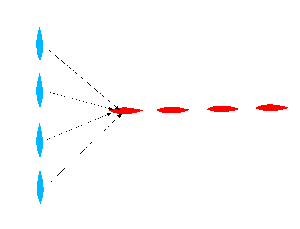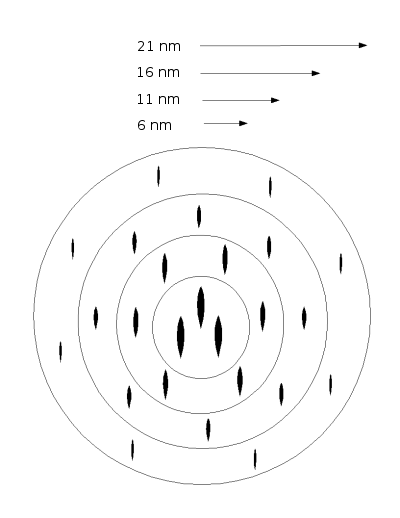![]() The Pacific War Online Encyclopedia
The Pacific War Online Encyclopedia
|
| Previous: Tashiro Sohei | Table of Contents | Next: Tasmania |
U.S. Navy. Via ibiblio.org
Task forces are groups of warships that sail together for mutual protection and to concentrate their firepower. They are usually ad hoc organizations assembled for a particular mission from elements of several warship squadrons or divisions and commanded by the senior admiral present. The term was used by the U.S. Navy and had no precise foreign
equivalent, but the underlying concept was universal. Much of the study
of tactics
in the prewar navies revolved around developing the best formations
(arrangements of ships around the flagship) for task forces. Standard
formations became part of naval doctrine.

The oldest such formation was the line ahead. This was a simple column of ships with the admiral in the lead ship, where he could order changes of course. The line ahead was easy to maneuver and, if it could position itself so that its target was to one side, it could concentrate the full broadsides of all the ships on the target. The tactically ideal situation was to "cross the T" of an enemy column , where the entire firepower of the crossing fleet could be brought to bear against the van (front) of the enemy column while the enemy would have great difficulty directing his own fire against the crossing fleet, as illustrated below:

The advantages of the line ahead were such that it became the basic
element of surface combat formations. The Japanese came up with such
variations as the L formation, in which a force sailing in line ahead
divided to box in the approaching enemy, so that his T would be capped
whichever way he turned.
However, the line ahead was not ideal in all situations. For example, it minimized the area that could be searched by a fleet. Such searches were best performed in line abreast:

The ships in such a formation were spaced far enough apart to maximize search but close enough to avoid leaving gaps and to allow the force to quickly move into line ahead formation if combat was imminent.
During the interwar period, both the Japanese and the Americans looked increasingly to circular cruising formations for maximum security against aircraft and submarines. In the U.S. Navy, this became U.S. Fleet Cruising Disposition Number Two, in which a force was divided into a core with three concentric outer rings:

The outer circle (Circle #1) consisted of submarines and was about 21 nautical miles in radius. Circle #2, with a radius of 16 nautical miles, consisted of individual picket destroyers. Circle #3, with a radius of about 11 nautical miles, consisted of light cruisers and destroyer divisions. Circle #4, with a radius of about six nautical miles, contained the core of the force. This was either a battle fleet or a convoy of merchants ships or both. If the task force was a battle fleet, the battleships ideally sailed in three divisions, each sailing in line ahead, one on the axis of advance and the other two in the beam positions. The circular formation provided effective screening against submarines, torpedo boats, and aircraft, and it could change course simply by having each ship come to the new course simultaneously.
The Japanese responded to the circular formation with a renewed emphases on night combat by light forces. Formations of destroyers flotillas accompanied by a division of heavy cruisers, called yasengun ("night combat groups") would attempt to break into the American formation to launch torpedoes at the battle line. These attacks were to be timed such that the American survivors would be engaged by the Japanese battle line at dawn.
British doctrine continued to be based on battleships sailing in line ahead, with
the destroyer screen taking up a vee or bent screen formation protecting
the battleships. The destroyers were organized into flotillas of two
divisions of four destroyers each, with a flotilla leader controlling
the flotilla. The flotilla was expected to operate as a unit so that it
could be more easily plotted by the admiral in command of the task
force, thereby reducing the risk of friendly fire incidents in the confusion of a fleet engagement.
Simplified versions of the circular formation became the chief task force formations used by the Allies throughout the war, and were later adopted by the Japanese. They proved particularly effective for carrier task forces, which changed course frequently to conduct flight operations.
The Japanese perfected a "box" formation that allowed up to six
fleet carriers to operate in close proximity, massing both their
offensive and defensive firepower.The Americans
experimented with carrier task forces composed of a single carrier
screened by cruisers and destroyers.
The two approaches reflected one of the unanswered questions tacticians
wrestled with early in the war, namely, should carriers be massed? It
is normally considered good tactics to mass firepower to avoid risking defeat in detail, but the
vulnerability of carriers to air attack led American tacticians to be
wary of putting all their eggs in one basket. The disaster at Midway
suggested that the Americans had the better argument, but the
relatively small number of carriers involved (three for the Americans,
four for the Japanese) left considerable uncertainty.
By March 1943 the Americans had concluded that the ideal was two carriers per task force, with the task forces concentrating for strikes and separating by at least 25 miles when air attack seemed imminent. The ideal screen was 20 to 24 destroyers and either six heavy cruisers, or two battleships and four antiaircraft cruisers. The destroyers were stationed in a circle at a radius of 1500 to 2500 yards from the center of the task force, with the heavier warships stationed closer to the carriers. In practice, there were simply not enough screening vessels for such extravagant protection, and most task groups consisted of three or four heavy or light carriers protected by fewer heavy warships and much fewer destroyers than the ideal. For example, Task Group 50.1 at Tarawa had two fleet and one light carrier screened by five heavy cruisers, one antiaircraft cruiser, and just eight destroyers.
The rapid growth of the U.S. Navy led to the adoption of additional
levels of organization within a task force. These were the task group,
which was often as large as the task forces of the early months of the
war, and the task unit, which could be a single ship or a small group
of ships within a task group.
References
Evans and Peattie (1997)The Pacific War Online Encyclopedia © 2013 by Kent G. Budge. Index